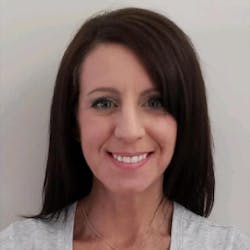Disruptive innovations in dentistry: How AI and machine learning are enhancing resin-based composites
Disruptive innovations are being seen within the dental space due to various reasons.1 Consumer demand, information technology, artificial intelligence (AI) technologies, as well as a generational shift in values are all affecting how dental care is being delivered.1 Examining and measuring patient outcomes and delivery of quality dental care begins with evaluating data, as comprehensive data supports patient care, treatment guidelines, and defines the quality of care.2 Data is generated at each point in the process of dental care, with the most valuable source being the electronic dental record (EDR). However, data is also found within digital radiographs, CBCT scans, intraoral images, and even when light-curing a restoration.
Two areas of focus in improving the quality of care have been on dental materials and the effectiveness of light-curing and the evolution of adhesive techniques in transforming the scope of dental practice.3 Dental providers can use basic methods to maximize adhesive performance, but how effective are these techniques and materials without looking at data to measure the outcomes?4 New and improved dental adhesive materials and the way they are polymerized are key components in the modification of dental restoration and placement.1 As a result, these paradigm changes are potentially more disruptive to traditional care models than in the past, and they will ultimately affect how dental care is delivered.1
For example, light curing is thought to be an uncomplicated procedure.5 The dentist preps the tooth for the restoration, places the restoration, and cures the restoration with a light-curing unit (LCU). Most LCUs have an audible timer, but the beep does not indicate that the resin material has fully cured; only that a certain time interval has lapsed.5 As the curing light gets older, issues can arise such as a decrease in light output due to degradation of the fiber-optic light probe, breakage and fracture of the light tip, and the presence of cured composite resin or debris on the exposed light tip.6 Consequently, dentists routinely see resin-based composite (RBC) restorations showing signs of chipping, fracture, discoloration, loss of anatomical form, lack of retention, or secondary caries.6 Of these, the most common reasons cited for replacement of light-activated RBC restorations are secondary caries and restoration fracture; therefore, it is very likely that many RBCs placed in dental offices are undercured.7
The key to clinical success of RBC placement is management of the four sets of variables that have been referred to as the CORE checklist.8 CORE stands for: curing light characteristics, operator technique, restoration characteristics (including location, size, and depth of the cavity relative to the position of the light tip), and energy requirement of the RBC being used (which is influenced by the shade of the RBC and spectral emission from the light to match the photo initiators used in the composite).8 Conversely, how effective is the CORE checklist if the clinician is relying on the time intervals of the curing light to determine solidarity of the restoration? Better yet, how can a practitioner monitor the energy delivered by the curing light? It is impossible to evaluate the quantity and quality of the light energy being delivered to cure a restoration.6 As a result, undercuring is of concern because inadequate resin polymerization adversely affects the resin’s physical properties. What can follow is a reduction in bond strength to the tooth, an increase in marginal wear, a decrease in the biocompatibility of the resin restoration, and potential growth of bacteria within the restoration.5 Equally important, overcuring can deliver too much energy, causing thermal damage to the pulp or other oral tissues that are exposed to the light.5
Each variable of the CORE checklist is imperative to achieve an adequately cured restoration, but how does the operator inherently know the energy requirement of the RBC being used? Correct irradiance, exposure duration, and spectral emission must be delivered from the LCU, and unfortunately, every survey of LCUs used in dental offices has shown that many do not provide sufficient irradiance.7 Couple that with light-curing techniques used by many clinicians, and you have a restoration that will likely need to be replaced.7 To ensure that the RBC is optimally cured, dentists have a clinical responsibility to select and use RBCs and LCUs that are optimally matched.7 But with such a wide range of both currently available, optimal matching is practically unachievable.7 Likewise, every brand of composite and every shade of that brand have different energy requirements to polymerize the material, and most manufacturers do not specify the energy required to cure their resin.6 While some curing lights have blue and violet LEDs to compensate for changes made to resin over the years, such as added photoinitiators, there is not enough evidence-based literature about the clinical implications of these changes to make any recommendations for different curing lights and irradiance values.6
To account for inadequate energy delivery to RBCs, Bluelight Analytics, a Canadian-based company at the forefront of light measurement technology, has developed CheckUp and CheckMARC (Managing Accurate Resin Curing), both relatively new innovations that improve light-curing outcomes for dental practitioners worldwide.9 CheckUp is a dental radiometer that provides dentists with personalized insights and precise curing times for any combination of lights and materials.9 This device relies on machine learning to calibrate a nonlinear spectral response sensor and light interaction effects between the light and meter.10 Combined with the Bluelight app, the CheckUp radiometer helps dentists improve the outcomes of restorative procedures.11
CheckMARC is a specialized service that gives practitioners a quick, accurate, and documented verification of the light output of curing lights in a dental office.6 A report is generated that details an accurate measurement of the irradiance output of the LCU as well as manufacturer’s information on the factory specifications of the light, which can be cross-referenced to these measurements and future reports.6 The report is curing light-specific, and any changes in the light’s output can be visualized and corrective action taken.6 CheckMARC is the only professional light-testing service that uses AI combined with the world’s largest library of LCU spectral data to match lights with every brand and shade of resin materials to deliver adequate curing times.9 In fact, one study of LCU performance showed that the output of more than 40% of LCUs was ± >20% of specification, which indicates that dental providers cannot rely on manufacturer-stated output alone.12
Following the success of CheckMARC, Bluelight has partnered with 3M in the delivery of this service since 2014.13 3M will perform a complimentary test and identify the efficacy of a dental office’s curing lights, review the light-curing protocols currently in place, and work with the dental office to identify evidence-based opportunities to improve clinical outcomes and patient satisfaction.14 The beauty of the CheckUp unit is that it offers the same benefits as CheckMARC, with the added convenience of dentists being able to monitor their curing lights themselves and test them regularly—e.g., every day/week/month. Bluelight relies on customer feedback and original research for ideas and inspiration.9 Their extensive database of more than 133,000 light-curing tests spanning more than 29,000 dental clinics demonstrates a deep understanding of the relationship between curing lights and the materials they cure.13 By taking a data-driven approach to light curing, Bluelight gives dentists the clinical insights they need to help them deliver great patient care and perform restorations that last.13
Light curing is just one small part of the restoration process, but it has an oversized influence on the clinical outcome.9 It has been suggested that regulatory bodies should consider the need for mandatory testing of light-curing devices in private dental offices, similar to regulations enforced for x-ray units.6 Using the CheckUp unit can help ensure maximal photopolymerization of RBCs and satisfy the possible future recommendation for mandatory light testing, as well as reduce the risk of post-op issues and ensure more consistent restorative procedures.9 Unlike traditional models and methods, Bluelight offers disruptive innovation to light-curing practices. With the wide range of spectral light data available and the ability to calibrate LCUs to specific dental materials, this type of disruptive innovation displaces the existing dental industry and dental technology by creating something new that is considered more efficient and worthwhile for the dental practice.15
Related articles
- AI technology and teledentistry: Breaking barriers to dental care
- Innovations in dentistry: Navigational surgery, robotics, and nanotechnology
Editor’s note: This article first appeared in Through the Loupes newsletter, a publication of the Endeavor Business Media Dental Group. Read more articles at this link and subscribe here.
References
- Edelstein BL. Disruptive innovations in dentistry. J Am Dent Assoc. 2020;151(8):549-552. doi:10.1016/j.adaj.2020.05.003
- Burger D. ADA venture seeking to become go-to resource for clinical data. ADA News. August 11, 2020. Accessed December 3, 2020. https://www.ada.org/en/publications/ada-news/2020-archive/august/ada-venture-seeking-to-become-go-to-resource-for-clinical-data
- Freedman G. Adhesion: past, present, and future. Compendium. 2019;40(9). Accessed November 30, 2020. https://www.aegisdentalnetwork.com/cced/2019/10/adhesion-past-present-and-future
- Alex G. Adhesive dentistry: the good, the bad, and the ugly. Compendium. 2009;30(8). Accessed November 30, 2020. https://www.aegisdentalnetwork.com/cced/2009/10/adhesive-dentistry
- Federlin M, Price R. Improving light-curing instruction in dental school. J Dent Educ. 2013;77(6):764-772.
- Strassler HE, Price RB. Understanding light curing, part 2: (#174). Dentistry Today. DentalCEtoday. June 1, 2014. Accessed November 28, 2020. https://www.dentalcetoday.com/product/dentalce-product123/
- Sarrett DC. ADA professional product review: a publication of the council on scientific public affairs. J Am Dent Assoc. 2013;144(7):841-842.
- Strassler HE, Price RB. Understanding light curing, part 1: (#173). Dentistry Today. DentalCEtoday. May 1, 2014. Accessed November 28, 2020. https://www.dentalcetoday.com/product/dentalce-product122/
- Patients trust you. Can you trust your curing light? Bluelight Analytics. Accessed November 28, 2020. https://www.bluelightanalytics.com/products/dentists
- Palin WM, Hadis MA, Shortall AC. Effect of light tip optical design on dental radiometer accuracy. Dental Materials. 2019;35(Suppl 1):e28. doi:10.1016/j.dental.2019.08.057
- DrBicuspid Staff. Bluelight Analytics, 3M Oral Care join forces. DrBicuspid. December 17, 2020. Accessed December 18, 2020. https://www.drbicuspid.com/index.aspx?sec=log&itemID=327787
- Christoferson C, Ferracane J, Felix C. Curing light output specifications compared to measured output at 439 dental offices. International Association for Dental Research. 2015. Accessed December 14, 2020. https://iadr.abstractarchives.com/abstract/15iags-2120917/curing-light-output-specifications-compared-to-measured-output-at-439-dental-offices
- Bluelight Analytics joins forces with 3M Oral Care to introduce Bluelight CheckUp. AEGIS Dental Network. December 15, 2020. Accessed December 17, 2020. https://www.aegisdentalnetwork.com/news/2020/12/15/bluelight-analytics-joins-forces-with-3M-oral-care-to-introduce-bluelight-CheckUp
- 3M partners with BlueLight Analytics to offer the checkMARC® Curing Light Testing service. News release. 3M. January 18, 2017. Accessed November 28, 2020. https://www.3m.com/3M/en_US/dental-us/resources/dental-press-releases/full-story/?storyid=6b068a99-ed14-4de4-9333-7fef78a5e510
- Mitrani R. Disruptive innovation in the dental marketplace. Spear Education. March 23, 2020. Accessed December 3, 2020. https://www.speareducation.com/spear-review/2020/03/disruptive-innovation-in-the-dental-marketplace-part-1
About the Author
Shannon Sommers, MSHI, BTDH, RDH
Shannon Sommers, MSHI, BTDH, RDH, has a bachelor's of technology in dental hygiene from the State University of New York at Canton and a master of science in health informatics from the Medical University of South Carolina. She has over 20 years’ experience in dentistry and has been a dental hygienist since 2006. She aims to use her dental background and informatics skills to influence population health by promoting and advancing the use of dental informatics.
Updated September 23, 2020
Alicia Webb, MSHI, BTDH, RDH
Alicia Webb, MSHI, BTDH, RDH, has been a clinician in dentistry since 2006 and has experience as an educator in dental hygiene. As one of the few registered dental hygienists to graduate with a master of science in health informatics, she wants to use her informatics knowledge coupled with her dental background to improve population health by developing and analyzing data-driven solutions to improve the delivery of quality dental care.
Updated September 23, 2020


